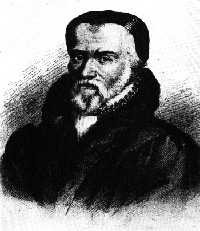Blessed Lord, who has caused all holy Scriptures to be written for our learning; Grant, that we may in such wise hear them, read, mark, learn, and inwardly digest them, that by patience, and comfort of thy holy Word, we may embrace, and ever hold fast the blessed hope of everlasting life. -- The Book of Common Prayer, 1662
William Tyndale
As a young man, William Tyndale is said to have promised a priest that he would eventually make it possible for a boy driving a plough to know as much of the Scriptures as did the priest.
Educated at Magdalen Hall, Oxford, and Cambridge, William Tyndale was appalled by the ignorance of parish priests, and was persuaded by this to translate the Bible into English.
The English Bible had been  banned since 1480, mostly because the Wycliffe Bible had been used by the outlawed Lollards, and Tyndale wanted to produce a better translation. Rather than translating from the Latin Vulgate, as Wycliffe had, he would work from the Greek and Hebrew of the original Old and New Testaments. banned since 1480, mostly because the Wycliffe Bible had been used by the outlawed Lollards, and Tyndale wanted to produce a better translation. Rather than translating from the Latin Vulgate, as Wycliffe had, he would work from the Greek and Hebrew of the original Old and New Testaments.
While he had hoped to have the support of the bishops in England, but they feared that an English translation would serve to spread Lutheran ideas; so fearful, in fact, that Tyndale soon found that his life was in danger.
Fleeing to Germany in 1524, he met with Martin Luther at Wittenberg, and in the following year completed his translation of the New Testament.
The printing of his translation was begun by William Royce, a reformist, but Royce was indiscreet and the project was soon being talked about. At the request of anti-Lutheran theologians, the city magistrates ordered the printing to stop.
|
